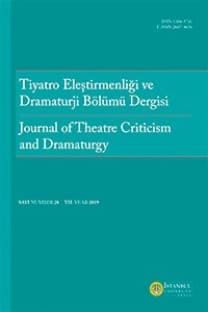Sahnede Robotlaşma
Bu çalışmanın amacı, posthümanizm felsefesi ışığında robotik bedenlerin konumunu sorgulamak ve bu bedenlerle ilişkisine göre insanların yeniden tanımına katkıda bulunmaktadır. Bunun yanı sıra, bu çalışmada hedeflenen bir diğer nokta artık hayatın pek çok alanında karşımıza çıkan robotların varlığını tiyatro sahnelerinde izleyip robotların sahne sanatlarındaki yerini de tartışmaktır. Dahası, tiyatro sahnelerinde ve konser salonlarında bir süredir karşımıza çıkan robotik bedenlerle karşı karşıya kalan ve bu bedenler vasıtasıyla insanlığın özüne ve süregelen konumuna ulaşan insanların insanlığını kaybetme korkusunun ve endişesinin nedenlerini de ortaya koymaktadır. Bu endişelerin kaynağının insan merkezli bakış açısıyla şekillenen felsefi akımlarla çizilmiş Üstün İnsan algısı olduğunu da gösteren bu çalışma, insanın aslında ne olduğunun robotlar da dâhil olmak üzere pek çok eyleyiciyle ilişkisine göre yeniden anlamlandırılması gerektiğinin altını çizmektedir.
Anahtar Kelimeler:
Posthümanizm, robot, robot oyuncular, robot tiyatrosu, robot aktörler
Robotization on Stage
This article aims to question the position of robotics and contribute to redefining humans based on their relationships with robotics within the framework of posthumanism. Apart from this, the article further analyzes the place of robots, which humanity is now facing in most of the areas in daily life, by tracing their existence in performance art and on stage. Moreover, this article grasps the essence and ongoing condition of humans through the robotic bodies that have been encountered for some time on theatre stages and in concert halls, thereby underscoring the human fear and anxiety over losing one’s humanity when faced with such bodies. Showcasing how the perception of human superiority as shaped by a human-centered perspective lies at the root of these anxieties, this article underlines the necessity to reconceptualize what being human actually means through humans’ entangled relationships with a number of agents, including robots.
Keywords:
Posthumanism, robot, robot performers, robot theatre, robot actors,
___
- Asimov, Isaac. I, Robot. New York, Gnome Press, 1950. google scholar
- Barad, Karen. Meeting the Universe Halfway: Quantum Physics and the Entanglement of Matter and Meaning. Durham: Duke University Press, 2007. google scholar
- Batukan, Can. Anima-lizm: İnsan, Hayvan ve Bitkilerde Ruh Üzerine. İstanbul: Altıkırkbeş Yayınları, 2016. google scholar
- Braidotti, Rosi. The Posthuman. Cambridge: Polity Press, 2013. google scholar
- Brooks, Rodney A. Flesh and Machines: How Robots Will Change Us. New York: Pantheon Books, 2002. google scholar
- Blinded Merseyside soldier ‘sees’ with tongue device. BBC. 2010. Erişim: http://news.bbc.co.uk/2/mobile/ uk_news/england/merseyside/8568485.stm google scholar
- Churchill, Caryl. Love and Information. Londra: Nick Hern Books, 2012. google scholar
- Collins, Nick. “Trading Faures: Virtual Musicians and Machine Ethics.” Leonardo Music Journal 21, (2011): 35-40. google scholar
- Courtland, Rachel. Review: The Uncanny Valley, a Play by Francesca Talenti that Puts a Robot Actor on Stage. Spectrum. (2015). Erişim: https://spectrum.ieee.org/geek-life/reviews/review-the-uncanny-valley google scholar
- Dawkins, Richard. River Out of Eden: A Darwinian View of Life. Londra: Weidenfeld and Nicolson, 1995. google scholar
- Derrida, Jacques. “The Animal That Therefore I am (More to Follow).” Çeviren David Wills. Critical Inquiry 28. 2, (2002): 369-418. google scholar
- Dinello, Daniel. Technophobia!: Science Fiction Visions of Posthuman Technology. Austin, Texas: University of Texas Press, 2005. google scholar
- Haraway, Donna J. Simians, Cyborgs, and Women: The Reinvention of Nature. New York: Routledge, 1991. google scholar
- Hayles, Katherine N. “How We Became Posthuman: Ten Years On An Interview with N. Katherine Hayles.” Paragraph 33.3, (2010): 318-330. google scholar
- Hayles, Katherine N. “Unfinished Work: From Cyborg to Cognisphere.” Theory, Culture and Society 23, (2006): 159-166. google scholar
- Hassan, Ihab. “Prometheus as Performer: Toward a Posthumanist Culture?” The Georgia Review 31.4, (1977): 830-850. google scholar
- Huxley, Aldous. Brave New World. New York: Vintage, 2004. google scholar
- Jones, Steve. The Language of the Genes: Biology, History and the Evolutionary Future. Londra: Flamingo, 2000. google scholar
- Latour, Bruno. Reassembling the Social: An Introduction to Actor-Network-Theory. Oxford: Oxford University Press, 2005. google scholar
- Pepperell, Robert. The Posthuman Condition: Consciousness Beyond the Brain. Bristol: Intellect Books, 2003. google scholar
- “Rimini Protokoll’den Tekinsiz Vadi.” https://teboyun.com/rimini-protokollden-tekinsiz-vadi/ google scholar
- Rosner, Krisztina. “The Gaze of the Robot: Oriza Hirata’s Robot Theatre.” The Theatre Times (2018). Erişim: https://thetheatretimes.com/the-gaze-of-the-robot/ google scholar
- Shimon Robot. Erişim: https://www.shimonrobot.com/info google scholar
- Soloski, Alexis. “SeinendanTheater Company and Osaka University Robot Theater Project Written and Directed by Oriza Hirata. Rev. of Sayanora and I, Worker, dir. Oriza Hirata.” Theatre Journal 65. 3, (2013): 400-402. google scholar
- Steckenfinger, Shawn A. ve Asif A. Ghazanfar. “Monkey Visual Behavior Falls into the Uncanny Valley.” Proceedings of the National Academy of Sciences of the United States of America 106. 43, (2009): 1836218366. google scholar
- ISSN: 1303-8605
- Yayın Aralığı: Yılda 2 Sayı
- Başlangıç: 2002
- Yayıncı: İstanbul Üniversitesi
